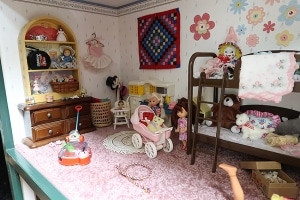 “Oh, let’s do the kitchen,” said Mary. “There are so many interesting things in the kitchen.” My Doll’s House (1932)
“Oh, let’s do the kitchen,” said Mary. “There are so many interesting things in the kitchen.” My Doll’s House (1932)
In August 2018, I received a research fellowship from The Strong. Thanks to The Strong’s support, I could see, touch, and “playʺ with the kitchen toys that girls in postwar America might have played with. The kitchen toys! But why the kitchen toys? Aren’t they just miniature kitchens and utensils? As an adult reflecting on my experiences as a girl, I recognize these artifacts as more than cute, little toys; rather, they are nostalgic cultural materials. The kitchen is not just a functional space where a family cooks and eats together. It is a gendered and educational space where, historically, a woman worked to feed her family and a daughter learned to be a good housewife. And, yes, those toys are the materials representing the kitchen.
The Strong provided me with several kitchen toy artifacts so that I could examine how they became meaningful to girls. In Doll Kitchens, 1800–1980 (1988), Eva Stille articulates that doll kitchen toys were girls’ historical play materials. Girls inherited their mothers’ toys and passed those on to their own daughters. For the girls, the kitchen was a fun place where they performed and played with their given gender roles… to be a good mom! The images displayed on the box covers of the Raggedy Ann Play Kitchen and Tupperware Mini-Serve-It Children’s Serving Set in The Strong’s collection depicted girls gleefully playing with the toys. They were cooking and serving other kids with the toys while wearing big smiles. Perhaps the girls were learning to be happy by successfully performing the role of a “mother.” Positive emotional attachment to kitchen could be constructed only by girls.
 Well, the girls might not have been able to resist the appeal of the kitchen toys. A refrigerator full of food, small utensils, an operational sink, and colorful miniature foods—how could they possibly throw them away? These toys in the postwar era portrayed the kitchen as a whimsical, sweet, warm, full, and satisfying space. The kitchen was a part of young girls’ life. For instance, look at the corner of Julie Conner’s girl’s miniature bedroom and you’ll discover a miniature kitchen with a little tea set and a baby in a high chair. The miniature kitchen Conner created displays a lively workspace: soup boiling on a stove, hot cookies in the oven, flour spread out on the countertop, and women and girls sharing food together in the kitchen. Thus, the kitchen toys were more than just fun toys. They gathered and perhaps connected “girls” together in a space, the kitchen.
Well, the girls might not have been able to resist the appeal of the kitchen toys. A refrigerator full of food, small utensils, an operational sink, and colorful miniature foods—how could they possibly throw them away? These toys in the postwar era portrayed the kitchen as a whimsical, sweet, warm, full, and satisfying space. The kitchen was a part of young girls’ life. For instance, look at the corner of Julie Conner’s girl’s miniature bedroom and you’ll discover a miniature kitchen with a little tea set and a baby in a high chair. The miniature kitchen Conner created displays a lively workspace: soup boiling on a stove, hot cookies in the oven, flour spread out on the countertop, and women and girls sharing food together in the kitchen. Thus, the kitchen toys were more than just fun toys. They gathered and perhaps connected “girls” together in a space, the kitchen.
As an early childhood educator and a researcher in childhood studies, I appreciate The Strong museum’s invaluable efforts to treat children’s toys as significant historical and cultural objects. The Strong’s fellowship allowed me to think about kitchen toys in different ways. As the famed scholar of play, Brian Sutton-Smith said in 1984, toys are playful materials that teach children relationships with the real world, symbolize a child’s real world, or represent a child’s culture. Thanks to the support of The Strong and curator Michelle Parnett-Dwyer, I could engage with toys that helped me navigate and capture the subtle but significant attachment between the kitchen and girls’ lives.
 Hours 10 a.m.–5 p.m. | Fri. & Sat. till 8 p.m.
Hours 10 a.m.–5 p.m. | Fri. & Sat. till 8 p.m.